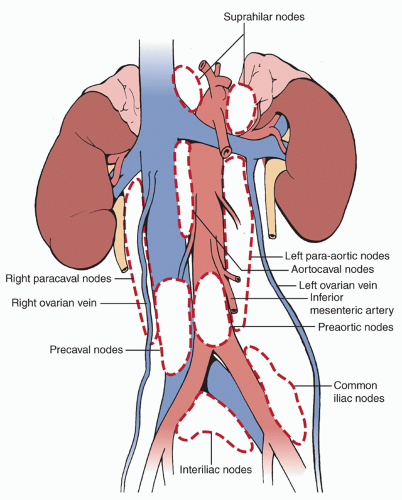Para-Aortic Lymphadenectomy
Robert E. Bristow
INTRODUCTION
The para-aortic lymph nodes are a common site of metastatic spread of ovarian cancer and endometrial cancer. Ovarian cancer has a predilection for lymphatic dissemination along the drainage routes of the ovarian vessels to the high para-aortic lymph nodes in proximity to the renal vessels. Endometrial cancer located in the uterine fundus may follow a similar spread pattern. In contrast, endometrial cancer located in the lower uterine segment or lower fundus will follow a more orderly lymphatic progression to the pelvic, common iliac, and low para-aortic (below the inferior mesenteric artery [IMA]) lymph nodes before reaching the high para-aortic nodal basins. Consequently, surgical removal of para-aortic lymph nodes is an important component of surgical staging for these cancers and may serve as a diagnostic procedure, a therapeutic procedure, or both. The extent of dissection, however, should be tailored to the specific disease process. Removal of gross para-aortic lymphadenopathy for patients with ovarian and endometrial cancers may be required to achieve optimal or complete tumor cytoreduction. Para-aortic lymphadenectomy may also be indicated for selected cases of cervical cancer undergoing radical hysterectomy when the common iliac lymph nodes are known to be involved by metastatic disease.
Para-aortic lymphadenectomy reflects complete or near-complete removal of all lymph node tissue within well-defined anatomic boundaries. The important anatomic landmarks are: distal—the mid-portion of the common iliac arteries; proximal—the left renal vein; lateral—the psoas muscles and ureters; and posterior—the anterior surface of the vertebral bodies. Within these boundaries, nine anatomic lymphatic zones are relevant to staging gynecologic cancers: right and left proximal common iliac, interiliac, precaval, right paracaval, aortocaval, preaortic, left para-aortic, and suprahilar (suprarenal) (Figure 12.1). Typically, each of these anatomic regions will yield between 3 and 6 lymph nodes, and the total lymph node count for para-aortic lymphadenectomy ranges from 10 to 26 lymph nodes. The retrocaval and retroaortic nodal basins are not routinely dissected during staging para-aortic lymphadenectomy. Some surgeons will limit the cephalad extent of para-aortic lymphadenectomy to the level of the IMA for selected cases of endometrial cancer or cervical cancer. However, para-aortic lymphadenectomy for the purpose of staging ovarian cancer should extend to the level of the renal vessels and include resection of the gonadal vessels at their origin. Para-aortic lymph node sampling is a more limited procedure within the same general anatomic boundaries as para-aortic lymphadenectomy but usually does not extend above the IMA and is intended to remove any enlarged or clinically suspicious nodes.
PREOPERATIVE CONSIDERATIONS
In preparation for para-aortic lymphadenectomy, all patients should undergo a comprehensive history and physical examination focusing on those areas that may indicate a reduced capacity to tolerate major surgery
or place the patient at elevated risk for postoperative complications. Routine laboratory testing should include a complete blood count, serum electrolytes, age-appropriate health screening studies, a chest radiograph, and electrocardiogram for women aged 50 years and older. Preoperative computed tomography of the abdomen and pelvis (and chest, depending on clinical indications) is helpful to evaluate the extent of disease and for surgical planning purposes.
or place the patient at elevated risk for postoperative complications. Routine laboratory testing should include a complete blood count, serum electrolytes, age-appropriate health screening studies, a chest radiograph, and electrocardiogram for women aged 50 years and older. Preoperative computed tomography of the abdomen and pelvis (and chest, depending on clinical indications) is helpful to evaluate the extent of disease and for surgical planning purposes.
Preoperative mechanical bowel preparation (oral polyethylene glycol solution or sodium phosphate solution with or without bisacodyl) is unnecessary for para-aortic lymphadenectomy but may be recommended according to the surgeon’s preference for other concurrent components of the procedure (e.g., hysterectomy and ovarian cancer surgery). Prophylactic antibiotics (Cephazolin 1, Cefotetan 1 to 2 g, or Clindamycin 800 mg) should be administered 30 minutes prior to incision, and thromboembolic prophylaxis (e.g., pneumatic compression devices and subcutaneous heparin) should be initiated prior to surgery. A self-retaining retractor (e.g., Bookwalter, Codman Division, Johnson & Johnson, Piscataway, NJ) with a fixed arm attaching the retractor ring to the operating table is advisable to optimize exposure, maximize patient safety, and reduce surgeon fatigue. Following is a brief description of the surgical procedure used (see also video: Para-aortic Lymphadenectomy).
SURGICAL TECHNIQUE
 The patient may be positioned in the dorsal low-lithotomy (perineal lithotomy) position using Allen Universal Stirrups (Allen Medical Systems, Cleveland, OH) or supine on the operating table, depending on the requirements for concurrent procedures. Para-aortic lymphadenectomy can be performed through a vertical midline incision extended above the umbilicus to the mid-epigastrium (or higher), laparoscopically, or robotically assisted. In general, it is not technically feasible to reach the high para-aortic
The patient may be positioned in the dorsal low-lithotomy (perineal lithotomy) position using Allen Universal Stirrups (Allen Medical Systems, Cleveland, OH) or supine on the operating table, depending on the requirements for concurrent procedures. Para-aortic lymphadenectomy can be performed through a vertical midline incision extended above the umbilicus to the mid-epigastrium (or higher), laparoscopically, or robotically assisted. In general, it is not technically feasible to reach the high para-aortic nodes through any of the low transverse incisions (Pfannenstiel, Maylard, Cherney), although these may be adequate for reaching the level of the IMA in thin patients. The surgeon may choose from a variety of instruments to perform para-aortic lymphadenectomy including scissors, hemo-clips, the electrosurgical unit (ESU) a vessel-sealing device, or the Argon beam coagulator. Lymphatic pedicles of the proximal and distal margins of dissection should be controlled either with clips or a vessel-sealing device to reduce the risk of postoperative lymphocyst formation. The specific choice of instrumentation is less important than achieving proper exposure and adhering to the anatomic boundaries of dissection.
Stay updated, free articles. Join our Telegram channel

Full access? Get Clinical Tree



